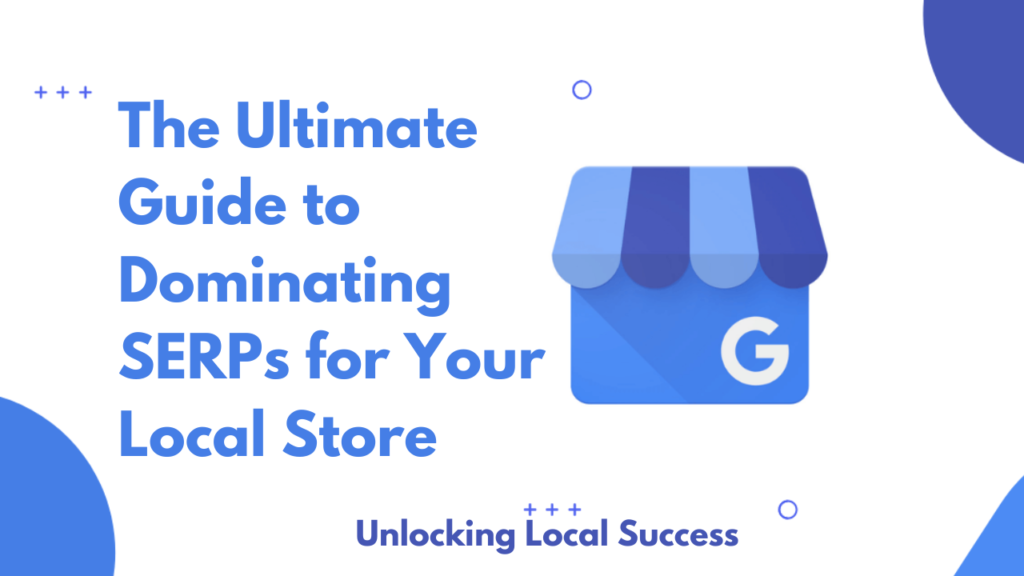Local SEO is crucial for brick-and-mortar stores, and by following some key steps, you can increase your chances of ranking high in Search Engine Results Pages (SERPs) for local searches.
Ranking your local store on top of SERPs (Search Engine Results Pages) involves a combination of strategies aimed at optimizing your online presence for local search queries. Here’s a comprehensive guide to help you achieve this:
Understanding Local SEO:
- Local SEO optimizes your online presence to attract customers searching for local businesses like yours. Google prioritizes various factors to deliver the most relevant local results.
Key Ranking Factors:
1. NAP Consistency:

NAP stands for Name, Address, and Phone number. Ensure your NAP information is consistent across your website, online directories, and social media profiles. Inconsistencies can confuse search engines.
2. Google Business Profile:
Claim and optimize your Google Business Profile (formerly Google My Business). This is a free tool that allows you to manage your business listing on Google Search and Maps. Include accurate details, high-quality photos, and positive customer reviews.
- Ensure all information is accurate and up-to-date, including store name, address, phone number (NAP), business hours, website URL, and category
- Add high-quality images of your store, products, and services.
3. Local Keywords:
Identify relevant keywords with local intent. These include phrases like “best [your service] near me” or “[your product] + [your city]”. Target these keywords throughout your website content, including titles, meta descriptions, and headings. Use tools like Google Keyword Planner, Ubersuggest, or SEMrush.
- Target long-tail keywords with local intent, including location-specific terms.
- Incorporate these keywords naturally into your website content, meta tags, headings, and alt tags
4. Positive Reviews:
Encourage customers to leave positive reviews on Google, Yelp, and other relevant platforms. Respond to both positive and negative reviews professionally.
- Monitor and respond to reviews promptly, addressing any concerns or issues raised by customers.
- Showcase positive reviews and testimonials on your website and social media channels.
5. Local Content:
Create content that caters to your local audience. This could be blog posts about local events, guides related to your industry, or testimonials from satisfied local customers.
- Incorporate local keywords naturally into your blog posts and other content.
- Engage with the local community through your content, and encourage sharing on social media platforms.
6. Citations:
Citations are mentions of your business name, address, and phone number online, on directories, local websites, and business associations’ websites. Building citations from high-quality sources helps improve your local SEO.
- Ensure your business is listed accurately on online directories, such as Yelp, Yellow Pages, Bing Places, and industry-specific directories.
- Consistency is key: Ensure NAP information across all directories matches your GMB listing.
- Seek out opportunities to get listed on local websites, blogs, or community directories.
7. On-Page SEO:
- Optimize title tags, meta descriptions, and URLs with relevant keywords and location modifiers.
- Create unique and valuable content for your website, including landing pages optimized for specific locations or services.
- Ensure your website is mobile-friendly and loads quickly.
Use structured data markup (Schema.org) to provide search engines with detailed information about your business, such as operating hours, addresses, and reviews.
8. Local Link Building:
- Build relationships with local businesses, organizations, and influencers.
- Seek opportunities for local partnerships, sponsorships, or collaborations.
Earn backlinks from local websites, such as local news outlets, bloggers, or community organizations.
https://www.linkedin.com/embeds/publishingEmbed.html?articleId=8586442692214284379&li_theme=light
9. Social Media Optimization:
- Maintain an active presence on social media platforms popular in your local area.
- Share content related to your business, engage with followers and respond to messages and comments promptly.
Use location tags and hashtags relevant to your area in your social media posts.
10. Local SEO Audits and Monitoring:
- Regularly audit your local SEO efforts to identify areas for improvement
- Monitor local search rankings, website traffic, and online reviews.
Adjust your strategy based on performance data and algorithm updates.
https://www.linkedin.com/embeds/publishingEmbed.html?articleId=7551868848977323066&li_theme=light
11. Stay Updated and Adapt:
- Keep abreast of changes in local search algorithms and best practices.
- Continuously adapt your local SEO strategy to stay competitive and maintain your rankings.
Additional Tips:
- Mobile-friendliness: Ensure your website is mobile-friendly, as many local searches happen on smartphones.
- Social Media Engagement: Be active on social media platforms like Facebook and Instagram. Share local content, engage with your community, and run promotions to boost local awareness.
- Internal Linking: Create a strong internal linking structure on your website, linking relevant local pages to each other
